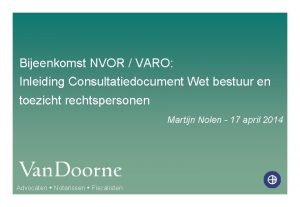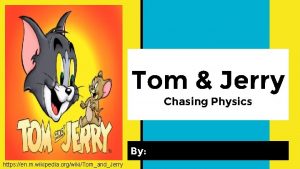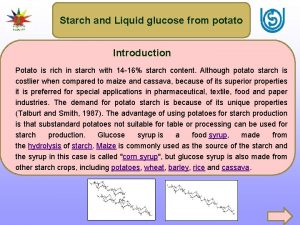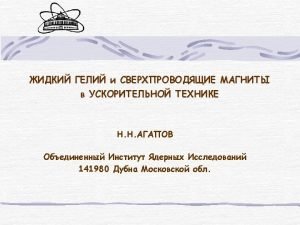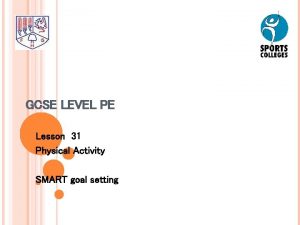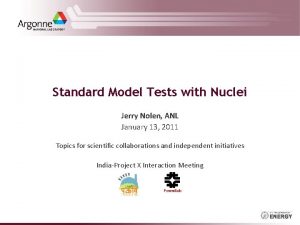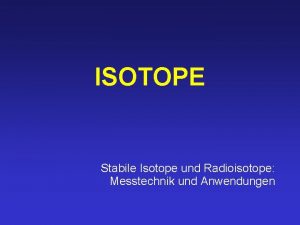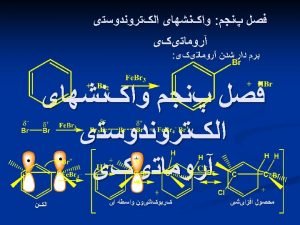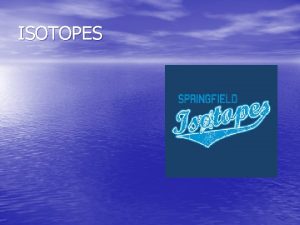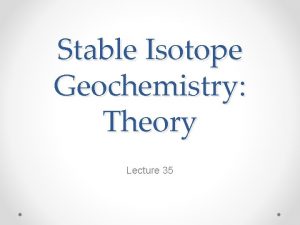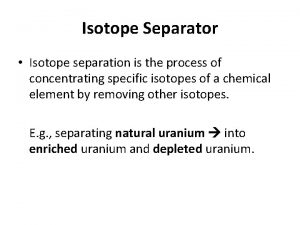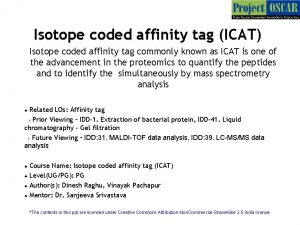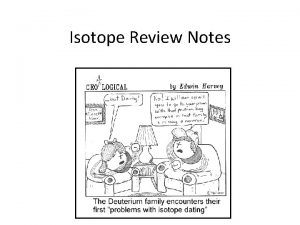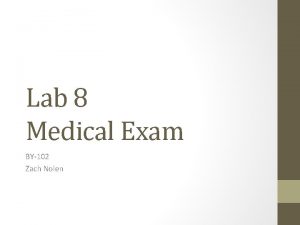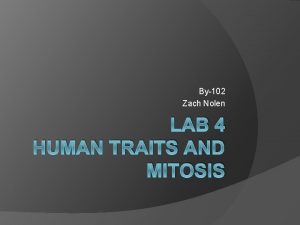Liquid targets for isotope production Jerry Nolen Physics


















- Slides: 18

Liquid targets for isotope production Jerry Nolen Physics Division, Argonne National Laboratory Nu. Fact'11 XIIIth Workshop on Neutrino Factories, Superbeams and Beta-beams CERN and University of Geneva August 3, 2011 This work was supported by the U. S. Department of Energy, Office of Nuclear Physics, under Contract No. DE-AC 02 -06 CH 11357.

High-Q and Low-Q pairs Isotope 6 He 18 Ne A/Z 3 1. 8 decay b- b+ t 1/2 [s] 0. 81 1. 67 Q [Me. V] 3. 51 3. 0 Isotope 8 Li 8 B A/Z 2. 7 1. 6 decay b- b+ t 1/2 [s] 0. 83 0. 77 Q [Me. V] 12. 96 8 Li and 8 B 6 He and 18 Ne t 1/2 at rest (ground state) 1 ms – 1 s 1 – 60 s 13. 92 Nu. Base Higher Q-value gives higher n-energy, better x-sections but needs longer baseline 2011 -08 -02 Nufact 11, Beta Beam Physics, Elena Wildner 2

CERN Beta Beams, Synoptic RCS SPL Dotted lines: alternative layouts Linac 4 Linac Molten Salt Loop ISOL target 6 He Baseline Collection PR 18 Ne n-Beam 8 B/8 Li 6 He/18 Ne ECR RFQ Linac 100 Me. V DR PS SPS PS and SPS existing RCS Decay Ring: Br ~ 500 Tm, B = ~6 T, C = ~6900 m, Lss= ~2500 m, g = 100, all ions 2011 -08 -02 Nufact 11, Beta Beam Physics, Elena Wildner 3

The Production Ring (8 B and 8 Li) “Inverse”: 6 Li beam on 3 He gas jet. “Direct”: 3 He beam on 6 Li target. Production of 8 B and 8 Li C. Rubbia, EUROnu proposal § § Aachen Univ. , GSI, CERN Gas Jet target proposed in FP 7: § too high density would be needed § vacuum problems Direct Production (D. Neuffer) with liquid film targets § Collaboration ANL (Benedetto/Nolen) Can liquid lithium targets be used at the necessary power levels? § High-Q 8 B and 8 Li will not be considered for the time being § We will not explore the low-Q gamma 350 option 2011 -08 -02 Nufact 11, Beta Beam Physics, Elena Wildner 4

Direct vs. inverse kinematics INVERSE DIRECT 8 Li/8 B emitted at q~10 o similar energy as projectile Supersonic jet target Efficient cooling removal Low densities Collection + diff. /effusion K 30 o emission angle and smaller velocity L Larger M. C. Scattering Larger emittance, less SC Solid/liquid target Cooling / jet instabilities High densities Collection? Spectrometer? See also D. Neuffer, NIM A 585 (2008) 109 E. Benedetto, ICE Meeting, 25/1/11

Production/cooler rings: direct or inverse kinematics Liquid targets for isotope production 6

Recent presentation by the Argonne liquid lithium group Thin liquid lithium targets for high power density applications: heavy ion beam strippers and beta beam production Presented at 4 th High Power Targetry Workshop May 2 nd to May 6 th 2011 Hilton Malmö City Claude Reed, Jerry Nolen, Yoichi Momozaki, Jim Specht, Dave Chojnowski, Ron Lanham, Boni Size, and Richard Mc. Daniel Nuclear Engineering Division and Physics Division Liquid targets for isotope production 7

Thick target and thin target development 20 k. W beam on Target JInst 4: P 04005 (2009) Liquid targets for isotope production 8

High Power Test of a Liquid-Lithium Fragmentation Target Side view nozzle A 20 k. W electron beam produces the same thermal load as a 200 k. W U beam on the windowless liquid Li target. Li jet Flow @ 8 m/s beam spot Li jet is confirmed stable in vacuum with a U beam equivalent thermal load. 20 k. W beam on Target Top view nozzle 10 mm 5 mm to viewport beam 20 o Power density is 8 MW/cm 3 @ 400 k. W beam power at 200 Me. V/u. High Power Targets for Radioactive Beam Facilities 9

Thermal Design Analysis for Liquid Metal Windowless Targets Y. Momozaki, J. A. Nolen, C. B. Reed, J. Bailey, and P. Strons The Third High-Power Targetry Workshop by Paul Scherrer Institut September 10 to 14, 2007 Bad Zurzach, Switzerland

Background 20 k. W E-beam-on-Target Test at ANL n MCNPX : for RIA, 200 -k. W uranium beam on Li 1 Me. V, 20 m. A, 1 mm e-beam on Li } peak energy deposition = 2 MW/cm 3 deposited in the first 4 mm n Test Objectives: Using this equivalence, demonstrate that power densities equivalent to a 200 k. W RIA uranium beam: • Do not disrupt the Li jet flow • Li T (across beam spot) is modest (~ 180º C) • Li vapor pressure remains low n Overall Objective: To show that 2 MW/cm 3, deposited in the first 4 mm of the flowing lithium jet, can be handled by the windowless target 11

What Experiment Indicates: power density for 1 -Me. V, 20 -k. W e-beam n Thermal analysis – 3 D Results (using Star CD) 2. 5 mm e-beam 10 mm n Estimated maximum temperature in the Li target is 872 K. 12

n Sn beam-dump for AEBL, ANL, USA Beam center at 0. 02 m, = 0. 015 m Thermal Design Analysis for a liquid tin beam dump for uranium beams n Estimated maximum temperature in the Li target is 912 K (Psat ~ 1. 8 10 -7 Pa for Sn). 13

Power density expectations give limitations for internal thin liquid lithium target size and speed § Our prediction is for a peak temperature of 941 K in a 13 micron thick film flowing at 58 m/s and 624 W deposited by a uranium beam with a 3σ beam width of 1 mm – Because of the high speed linear flow only the beam width is relevant – A 13 micron film is 0. 65 mg/cm 2, so a 1 mg/cm 2 thickness can take 960 W/(mg/cm 2) per mm of width – From David Neuffer’s paper the internal target can be 3. 6 mg/cm 2 in thickness, and hence can take 3. 5 k. W per mm of width – He also predicts a power deposit from the 3 He beam of 500 k. W, so the width of the beam spot must be 143 mm at 58 m/s to keep the same temperature rise – If we can increase the speed to 200 m/s then the width can be 41 mm § Issues: – The beam spot can be 41 mm wide by 1 mm tall, so is this size beam on target compatible with the ring optics? (the slit-shaped beam is probably good for the recoil collection geometry) – Can we scale the speed to 200 m/s or more? (requires ~500 psia pressure – probably OK) – Can we make a film 41 mm wide and 72 microns thick? (I think so) Liquid targets for isotope production 14

Other potential uses of liquid metal technology at neutrino factories § Alternative for production of 8 B via fragmentation of 10 B – ~1 MW 10 B beam at ~200 Me. V/u can produce in-flight 1 E 13 8 B per second using a liquid lithium cooled target – The 8 B is formed at high energy and already fully stripped – Studies of transverse and longitudinal cooling are necessary to compare overall rates with “ISOL” methods § The 2 -step 6 He production target can probably benefit from liquid lithium cooling of the tungsten neutron converter § The “pebble-bed” pion production target concept can probably benefit from liquid lithium cooling of the pebbles Liquid targets for isotope production 15

Concept for a liquid-lithium cooled tungsten neutron converter for radioactive beams of fission fragments This concept is applied to production of 6 He by replacing the uranium with Be. O Liquid lithium cooling enables a more compact geometry Liquid targets for isotope production 16

Slide from Tristan Davenne at EUROnu’ 11: Liquid metal cooling can be considered Packed Bed Target Concept for Euronu (or other high power beams) Titanium alloy cannister containing packed bed of titanium or beryllium spheres Cannister perforated with elipitical holes graded in size along length Packed bed cannister in parallel flow configuration Packed bed target front end Model Parameters Proton Beam Energy = 4. 5 Ge. V Beam sigma = 4 mm Packed Bed radius = 12 mm Packed Bed Length = 780 mm Packed Bed sphere diameter = 3 mm Packed Bed sphere material : Beryllium or Titanium Coolant = Helium at 10 bar pressure

Summary § Initial estimates indicate that 8 B production via 3 He stored beam on a thin 6 Li target is not far from feasible (2 H beam on 7 Li target is less demanding) § Beam-on-target tests of the thin lithium film is the next priority for the FRIB stripper development § An update of the ring parameters required for necessary production rates should be done § Ring and cooling/heating dynamics with a slitshaped beam spot on target must be investigated § Liquid lithium technology is possibly applicable in other aspects of neutrino factory targetry Liquid targets for isotope production 18
 Martijn nolen
Martijn nolen Production process flow chart
Production process flow chart Tom and jerry bad physics
Tom and jerry bad physics Difference between pure liquid and commercial liquid
Difference between pure liquid and commercial liquid Liquid liquid extraction unit
Liquid liquid extraction unit Starch to liquid glucose production
Starch to liquid glucose production Liquid helium production
Liquid helium production Objectives of warehousing
Objectives of warehousing Writing learning targets
Writing learning targets Racial etiquette targets
Racial etiquette targets Brides magazine targets consumers who are in
Brides magazine targets consumers who are in Targets of change
Targets of change Smart pe gcse
Smart pe gcse Learning targets
Learning targets Identifying market segments and targets chapter 9
Identifying market segments and targets chapter 9 Identifying market segments and targets
Identifying market segments and targets Cross projection sketch
Cross projection sketch Reasoning learning targets examples
Reasoning learning targets examples Learning targets knowledge, reasoning, skill product
Learning targets knowledge, reasoning, skill product
